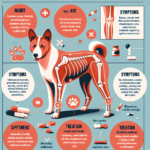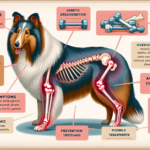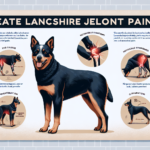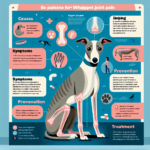Rottweiler Joint Pain: Causes, Symptoms, Prevention, and Treatment
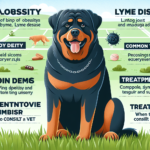
Introduction
Overview of Rottweilers: The Rottweiler is a robust and powerful breed with a rich history dating back to the Roman Empire. Originally bred to herd livestock and pull carts, Rottweilers are known for their strength, loyalty, and protective nature. They have a distinctive black coat with rust-colored markings and are often employed in roles such as search and rescue, police work, and as guard dogs.
General Health Concerns: Like many large breeds, Rottweilers are prone to certain health issues, including heart problems, cancer, and joint-related conditions. Joint pain is a significant concern for Rottweilers due to their size and the physical demands often placed on them.
Importance of Joint Health in Rottweilers: Joint health is crucial for Rottweilers to maintain their mobility and quality of life. Given their active nature and the physical roles they often undertake, ensuring their joints remain healthy is essential for their overall well-being and longevity.
Breed-Specific Joint Pain Risks
Genetic Predisposition
Rottweilers have a genetic predisposition to several joint-related issues, including hip dysplasia, elbow dysplasia, and arthritis. Hip dysplasia, a condition where the hip joint doesn’t fit properly into the hip socket, is particularly common in this breed. Elbow dysplasia, which involves abnormal development of the elbow joint, can also affect Rottweilers, leading to pain and lameness.
Age-Related Risks
As Rottweilers age, the risk of developing joint pain increases. Degenerative joint diseases such as osteoarthritis become more prevalent in older dogs. Owners should be vigilant about joint health as their Rottweiler reaches middle age, typically around 5-7 years old, and continue monitoring into their senior years.
Activity Level and Joint Stress
Rottweilers are known for their high energy levels and physical strength. Whether they are working dogs, participating in sports, or simply enjoying an active lifestyle, the stress on their joints can be significant. Activities that involve jumping, running, or sudden changes in direction can exacerbate joint issues, making it essential to balance exercise with joint care.
Common Symptoms of Joint Pain in Rottweilers
General Symptoms
- Limping: One of the most noticeable signs of joint pain is limping or favoring one leg over another.
- Stiffness: Stiffness, especially after rest or sleep, can indicate joint discomfort.
- Reluctance to Move: A dog that is hesitant to climb stairs, jump, or even go for walks may be experiencing joint pain.
- Swelling: Swelling around the joints can be a visible sign of inflammation and pain.
- Behavioral Changes: Irritability, lethargy, or changes in appetite can also be associated with joint pain.
Breed-Specific Symptoms
In Rottweilers, joint pain may manifest more prominently in the hips and elbows due to their predisposition to dysplasia in these areas. Owners may notice a “bunny hopping” gait or difficulty rising from a lying position, which are indicative of hip issues. Elbow pain may cause the dog to hold its front leg out to the side or avoid putting weight on it.
When to Consult a Vet
If a Rottweiler exhibits any of the above symptoms persistently or if the symptoms worsen over time, it is crucial to consult a veterinarian. Early intervention can help manage pain and slow the progression of joint diseases.
Preventive Measures for Joint Health
Exercise Recommendations
Regular, moderate exercise is essential for maintaining joint health in Rottweilers. Activities such as swimming, walking, and controlled play can help keep joints flexible without causing excessive stress. Avoid high-impact activities like jumping or running on hard surfaces, especially for young puppies whose joints are still developing.
Dietary Suggestions
A balanced diet rich in essential nutrients supports overall health and joint function. Foods containing glucosamine, chondroitin, and omega-3 fatty acids can be particularly beneficial for joint health. These nutrients help reduce inflammation and support cartilage repair. Consult with a veterinarian to choose the best diet or supplements for your Rottweiler.
Weight Management
Maintaining a healthy weight is crucial for reducing stress on the joints. Obesity can exacerbate joint pain and lead to other health issues. Regularly monitor your Rottweiler’s weight and adjust their diet and exercise routine as needed to keep them at an optimal weight.
Early Screening and Monitoring
Early screening for joint issues can help catch problems before they become severe. Regular veterinary check-ups, including X-rays and physical exams, can identify early signs of dysplasia or arthritis. Genetic testing may also be available to assess the risk of inherited joint conditions.
Treatment Options for Joint Pain
Non-Surgical Treatments
Non-surgical treatments for joint pain in Rottweilers include:
- Medications: Anti-inflammatory drugs, pain relievers, and joint supplements can help manage pain and inflammation.
- Physical Therapy: Exercises and therapies designed to improve joint function and reduce pain can be highly effective.
- Lifestyle Adjustments: Modifying activity levels and incorporating low-impact exercises can help manage joint stress.
Surgical Options
In severe cases, surgical intervention may be necessary. Common surgeries for joint pain in Rottweilers include:
- Hip Replacement: Total hip replacement can provide significant relief for dogs with severe hip dysplasia.
- Elbow Surgery: Procedures to remove bone fragments or correct joint alignment can alleviate elbow dysplasia symptoms.
- Arthroscopy: Minimally invasive surgery to clean out the joint and remove damaged tissue.
Alternative Therapies
Alternative therapies can complement traditional treatments and provide additional relief. Options include:
- Acupuncture: This ancient practice can help reduce pain and improve joint function.
- Hydrotherapy: Water-based exercises that reduce joint stress while improving strength and mobility.
- Massage: Therapeutic massage can help alleviate muscle tension and improve circulation around the joints.
Lifestyle and Management Tips
Daily Care Routine
A daily care routine for a Rottweiler with joint pain might include:
- Gentle morning walks to loosen stiff joints.
- Administering prescribed medications or supplements.
- Engaging in low-impact activities like swimming or controlled play.
- Providing a comfortable resting area with orthopedic bedding.
- Regularly monitoring for any changes in mobility or behavior.
Modifying the Home Environment
Making the home environment more comfortable for a Rottweiler with joint pain can involve:
- Installing ramps to help the dog navigate stairs or get onto furniture.
- Using non-slip mats to prevent falls on slippery surfaces.
- Providing an orthopedic bed to support joints during rest.
- Ensuring food and water bowls are at a comfortable height to reduce strain.
Long-Term Management
Long-term management strategies for joint pain include:
- Regular veterinary check-ups to monitor joint health and adjust treatments as needed.
- Maintaining a consistent exercise routine to keep joints flexible and muscles strong.
- Continuing with a balanced diet and appropriate supplements.
- Staying vigilant for any changes in mobility or behavior that may indicate worsening joint issues.
FAQs About Rottweilers and Joint Pain
What are the early signs of joint pain in Rottweilers?
Early signs include limping, stiffness, reluctance to move, and behavioral changes such as irritability or lethargy.
Can joint pain in Rottweilers be prevented?
While genetic predispositions cannot be entirely prevented, maintaining a healthy weight, providing a balanced diet, and ensuring regular, moderate exercise can help reduce the risk and severity of joint pain.
Are there specific exercises that are better for Rottweilers with joint pain?
Low-impact exercises such as swimming and walking on soft surfaces are ideal for Rottweilers with joint pain. Avoid high-impact activities that can exacerbate joint stress.
What dietary supplements are recommended for joint health in Rottweilers?
Supplements containing glucosamine, chondroitin, and omega-3 fatty acids are commonly recommended to support joint health and reduce inflammation.
When should I consider surgery for my Rottweiler’s joint pain?
Surgery should be considered when non-surgical treatments are no longer effective, and the dog’s quality of life is significantly impacted by joint pain. Consult with a veterinarian to determine the best course of action.
Conclusion
Joint pain is a common issue for Rottweilers, but with proper care and attention, it can be managed effectively. By understanding the causes, symptoms, and preventive measures, owners can help ensure their Rottweilers maintain healthy joints and enjoy a high quality of life. Regular veterinary consultations, a balanced diet, appropriate exercise, and early intervention are key to keeping your Rottweiler active and happy. Always consult with your veterinarian for personalized advice and treatment options tailored to your dog’s specific needs.

